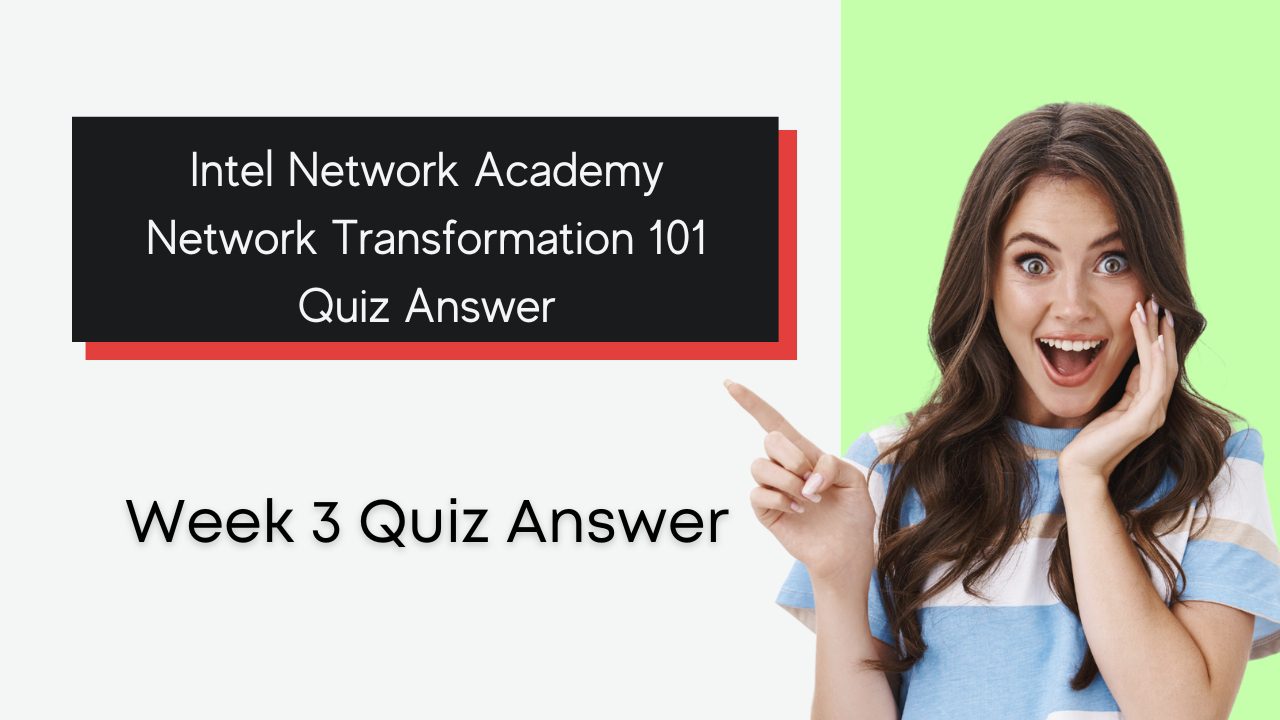In this article i am gone to share Coursera Course: Intel Network Academy – Network Transformation 101 Week 3 Quiz Answer with you..
Week 3 Quiz Answer
Network Functions Virtualization (NFV) and Virtual Network Functions (VNFs)
Question 1) Which of the following is the correct definition of NFV?
- NFVuses software to standardize network node functions.
- NFVuses IT technologies to virtualize network node functions.
Question 2) Select the terms, in the correct order, to complete the phrases below:
A ________may consist of one or more virtual machines running different software and processes.
NFVI is part of the _____ platform including virtualization layer and hardware for computing, storage and networking.
- NFVI, VNF
- VNF, NFV
- NFVI, NFV
Question 3) Which of the following are accurate statements regarding NFV? (Select all that apply.)
- Delivers services based on volume servers running software VNFs, instead of single purpose boxes.
- Helps transform architecture from traditional networking topology to networking within VMs.
- Enables a physical model where services are on dedicated hardware dependent on network topology.
Communications Service Providers (CommSPs) And the NFV Transition
Question 1) Which of the following does NFV transformation enable for CommSPs? (Select all that apply.)
- Decreased OpEx
- Increased OpEx
- Services in new locations
- Decreased CapEx
Question 2) What does NFV accelerate in terms of network maintenance? (Select all that apply.)
- Automated fault detection and resolution
- Reactive fault detection
- Root cause analysis for faster fault detection and prevention
Question 3) Which of the following are key drivers pushing the NFV transition for CommSPs?
- Digital diversification
- Business agility
- Platform innovations
- Network leadership
- All of the above
The Adoption of NFV
Question 1) True or false: As CommSPs begin to transition to NFV, capabilities requirements increase.
- True
- False
Question 2) True or false: When creating NFV standards,
specifications, software and architecture using an evolved methodology, outputs are standards and specifications.
- True
- False
NFV Orchestration
Question 1) What is the goal of orchestration?
- Automated software and hardware lifecycle management
- Evolved service and application lifecycle management
- Cyclical software and hardware management
- Automated service and application lifecycle management
Question 2) Which of the following statements are accurate regarding model-driven orchestration?
- Model-driven orchestration is a powerful approach to on-boarding services, instantiating them, and managing their lifecycle.
- A service model can be created using a declarative, human readable language.
- The Service Orchestrator uses the service model and the infrastructure model to manage the service through its lifecycle.
- All of the above
Question 3) True or false: YANG is the data modeling language used in the Network Configuration Protocol (NETCONF).
- True
- False
Question 4) True or false: TOSCA aims to enhance the portability of cloud applications and services.
- True
- False
Meeting the Service Assurance Challenge to NFV
Question 1) In relation to Service Assurance, what is FCAPS?
- Fault, Configuration, Accounting, Performance, Service
- Fault, Configuration, Accounting, Programming, Security
- Fault, Configuration, Accounting, Performance, Security
- Fault, Computing, Accounting, Performance, Security
Question 2) (True or False) Service assurance components must transform into common open standard components and interfaces for Open NFV Platform and Service Assurance.
- True
- False
Question 3) True or false: Open Service Assurance addresses the service assurance barrier in the path to adoption of NFV and required service enhancements
- True
- False
SDN Overview
Question 1) Read the description below, then select the term that matches the description.
An architectural approach where one separates out the application layer from the control layer and also from the infrastructure layer. It’s not fixed-function logic and interfaces are all open and vendor neutral.
- Software Defined Infrastructure
- Network Function Virtualization
- Software Defined Network
Question 2) Read the description below, then select the term that matches the description.
Takes similar concepts and broadens them to do more than just networking such as storage and compute. This type tries to achieve better efficiencies by having defining things through a software approach rather than fixed function hardware.
- Software Defined Network
- Software Defined Infrastructure
- Network Function Virtualization
Question 3) Select a term that fills in the blank to correctly complete the phrase below:
______ use SDN to reduce the overall cost of network operation and allow for the development of new incremental revenue sources through business innovation.
- Enterprises
- Cloud Service Providers
- Communication Service Providers
Question 4) Select a term that fills in the blank to correctly complete the phrase below:
Using SDN, ___________ can achieve massive levels of scale while maintaining service level agreements and adapting to changes in customer demands while reducing overall cost of delivery.
- Enterprises
- Cloud Service Providers
- Communication Service Providers
Question 5) Select a term that fills in the blank to correctly complete the phrase below:
___________ leverage SDN to deliver business value as fast as possible and with lowest total cost of ownership.
- Communication Service Provider
- Cloud Service Providers
- Enterprises
Question 6) What are the benefits of SDN? (Select all that apply.)
- Centrally managed
- Agile
- Directly programmable
- Open standards-based and vendor neutral
- Programmatically configured
Network Slicing
Question 1) True or false: One challenge of network slicing is that multiple applications and different end-to-end requirements make it difficult to implement separate networks.
- True
- False
Question 2) Which of the following is a platform enabler for network slicing?
- Mobile Edge Cloud Node
- Last Level Cache (LLC) slicing
- Packets Classification slicing
- All of the above
Intel Network Academy – Network Transformation 101 Coursera Answer
Intel Network Academy – Network Transformation 101 Week 1 Quiz Answer
Intel Network Academy – Network Transformation 101 Week 2 Quiz Answer
Intel Network Academy – Network Transformation 101 Week 3 Quiz Answer


2 thoughts on “Intel Network Academy Network Transformation 101 Week 3 Quiz Answer”